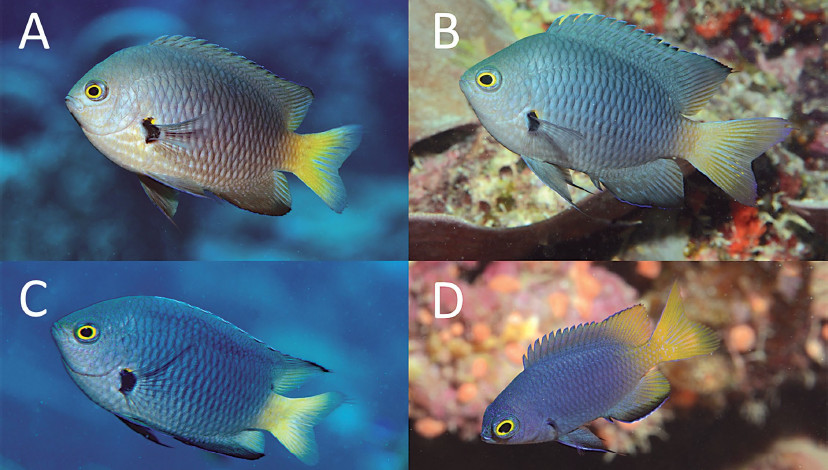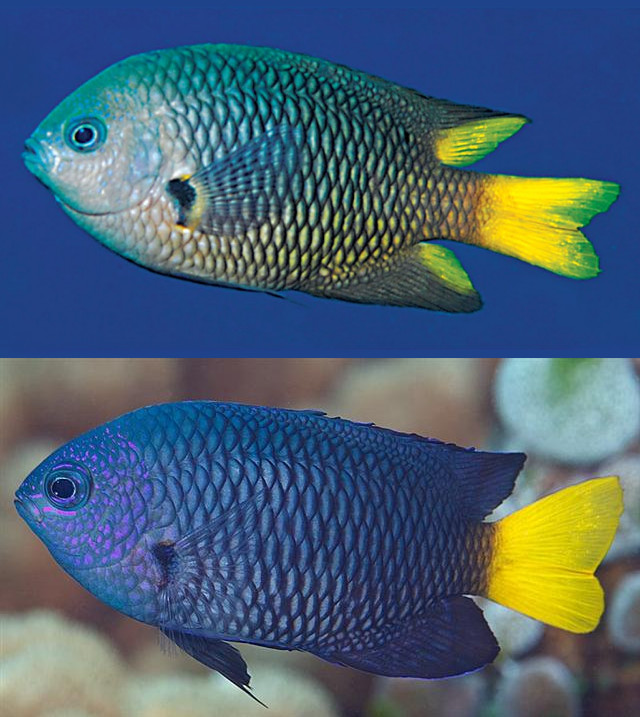
Pomacentrus flavioculus, Lau Archipelago, Fiji, underwater photographs: A) approx. 70 mm SL, B) approx. 55
mm SL, C) subadult, approx. 45 mm SL, D) juvenile, approx. 20 mm SL (G.R. Allen). Credit: Allen, Erdmann & Pertiwi 2017
Back in February, we welcomed into the world four new species of damselfishes from the Pomacentrus philippinus group, and now there’s a new member to meet: the Yelloweye Damselfish (P. flavioculus). It’s easily recognized in this species complex thanks to its namesake yellow eye, and it’s honestly a bit surprising that this fish could hide in plain sight for so long. Sure, it’s not the most vibrant or charismatic of species, but it has a bright yellow eye… how did that get overlooked?

Comparison of adult color patterns, approx 60–70 mm SL: A) Pomacentrus flavioculus, Fiji (G.R. Allen), B) P.
imitator, Coral Sea (I. Shaw). Credit: Allen, Erdmann & Pertiwi 2017
P. flavioculus is reported from both Fiji and Tonga, but previously it had been confused with another member in this group, P. imitator from the Coral Sea. The two are, however, quite different… P. imitator has a dark eye and white tail, while P. flavioculus is yellow in both. And genetically these are easily told apart, indicating a fairly lengthy period of isolation from one another.

Map of the western Pacific Ocean region with distributions of the Pomacentrus philippinus species complex. Credit: Allen, Erdmann & Pertiwi 2017
The biogeography of the P. philippinus group is proving to be quite fascinating, and there are almost certainly more species yet to be described here. The most obvious place to look is in the Maldives, which represents the westernmost extent of this lineage. Here, the resident population has a bright yellow caudal fin, with fully darkened dorsal and anal fins. Compare this to the true P. philippinus found in (you guessed it) the Philippines, and you’ll see an obvious difference in yellowed portions of the dorsal and anal fins. Based on the high level of speciation found in the eastern portions of the range, it’s probably not a stretch to assume that the true P. philippinus is a Filipino endemic, with separate taxa needing to be described from the Maldives, the Andaman Sea, Indonesia, and Papua New Guinea… but this awaits further study.

Differences between P. philippinus (top, Palawan) and P. cf philippinus (bottom, Maldives) Credit: G.R. Allen & Jim Greenfield
- Allen, G.R., Erdmann, M.V. & Pertiwi, P.D. (2017) Pomacentrus flavioculus, a new species of damselfish
from Fiji and Samoa (Teleostei: Pomacentridae). Journal of the Ocean Science Foundation, 28, 22–33. (pdf link) - Allen, G.R., Erdmann, M.V. & Purtiwi, P.D. (2017) Descriptions of four new species of damselfishes
(Pomacentridae) in the Pomacentrus philippinus complex from the tropical western Pacific Ocean. Journal of the
Ocean Science Foundation, 25, 47–76. (pdf link)










0 Comments